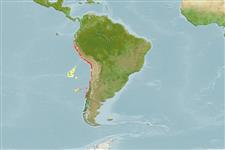Classification / Names
Common names from other countries
Main reference
Size / Weight / Age
Max length : 48.0 cm TL male/unsexed; (Ref. 1371)
Environment
Marine; bathydemersal; non-migratory; depth range 260 - 1480 m (Ref. 1371)
Climate / Range
Deep-water, preferred ?; 4°S - 39°S, 85°W - 70°W (Ref. 1371)
Distribution
Short description
Dorsal
spines
(total): 0;
Dorsal
soft rays
(total): 107-110;
Anal
spines: 0;
Anal
soft rays: 95. Head large; eyes large; snout moderately long, acutely pointed; head ridges strong, conspicuously modified. Light organ very small, scarcely visible externally as a swollen blackish area before the anus. Caudal fin absent. Color is grayish brown overall; the head dirty whitish ventrally; the fins, mouth and gill cavities blackish.
IUCN Red List Status (Ref. 115185)
Threat to humans
Harmless
Human uses
Fisheries: minor commercial
More information
Common namesSynonymsMetabolismPredatorsEcotoxicologyReproductionMaturitySpawningFecundityEggsEgg development
Age/SizeGrowthLength-weightLength-lengthLength-frequenciesMorphometricsMorphologyLarvaeLarval dynamicsRecruitmentAbundance
ReferencesAquacultureAquaculture profileStrainsGeneticsAllele frequenciesHeritabilityDiseasesProcessingMass conversion
Tools
Special reports
Download XML
Internet sources
Estimates of some properties based on models
Phylogenetic diversity index
PD50 = 0.5000 many relatives (e.g. carps) 0.5 - 2.0 few relatives (e.g. lungfishes)
Trophic Level
3.6 ±0.5 se; Based on size and trophs of closest relatives
Resilience
Low, minimum population doubling time 4.5 - 14 years (Preliminary K or Fecundity.)
Vulnerability
Moderate to high vulnerability (53 of 100)
Price category
